|
"Only by understanding the mechanism which connects him to the earth
and the sky will man be able to understand his physical and psychic
position in the universe today. In the context of the universe as it
is, man will find his natural role."
- Giorgio Piccardi
12. Cycles In The Universe
If cycles are not merely accidental, and if they are caused by
forces outside the earth, there are three possible sources: the sun,
the planets, and energy from outer space. No one of these, as I see
it, is any more fantastic or improbable than the others. All should
be investigated with equal impartiality.
Once, when mentioning the planets as a possible cause for some of
the cycles observed on earth, I was taken to task by a good friend.
"That's astrology," he said. "If you talk like that people will
think you are an astrologer. You will lose your scientific standing.
You will bring discredit upon the Foundation. Don't you know that
astrology is completely discredited and that therefore the planets
could have nothing whatever to do with it?"
Of course I know that astrology is completely discredited.
The idea
that planets could have any effect upon the events of individual
lives, according to their time of birth, is so fantastic that
science has rejected it out of hand without even bothering to
investigate it. The mere suggestion that it be investigated would
damn any scientist, and if his findings were favorable, I am sure no
scientific journal would publish his work.
Astrology is something like a religion. It is a belief, or a set of
beliefs, handed down from antiquity. It was an accepted belief as
late as the 1600's. Even Kepler took it for granted. Science has now
relegated it to the realm of folklore, chiefly because astrologers
have not used the methods of science to try to prove their case nor
have they been able to explain satisfactorily how any such planetary
influence on individual lives could possibly exist or operate.
In many ways astrology is similar to alchemy, the medieval
forerunner of chemistry. Alchemy, too, was a set of beliefs,
specifically that elements could be transmuted, or changed, one into
the other if only one knew enough. Making gold from lead was the
main objective.
Of course, essentially this has now been done. Elements have been
transmuted, but at a prohibitive cost.
But suppose, when the
scientists started to work on the project of converting one element
into another, someone had said,
"Stop! The old alchemists believed
that. Don't you know that the belief that elements can be transmuted
is alchemy?"
If someone had said that to our modern nuclear physicists, they
would have replied,
"Of course we know! When it's a belief, it is
nothing but a superstition, but when it's a proved and demonstrated
fact, it's science. It isn't the subject matter that governs, but
the method of study and evaluation. The fact that someone has a
belief in something should not make the subject matter taboo!"
My investigation of a possible connection between planetary cycles
and earthly cycles, if I should ever have time to make it, would
have nothing to do with astrological beliefs.
It would have nothing
to do with birth dates and other mumbo jumbo. It would concern
electromagnetic or similar forces in the universe that might affect
weather and various life processes, including human beings in the
mass.
Let us conjecture for a moment before we look up into the
universe in search of more cycles.
The Long Waves
Gamma rays, ultraviolet light, X rays, infrared rays, visible light,
radio waves, and secondary cosmic rays are all grouped together as
"electromagnetic radiation." Gamma rays and X rays can go right
through you and, in large doses, can destroy your tissues.
Visible light is what we all see with our eyes. Infrared rays can
burn us, while radio waves cause us no obvious harm. However, all
these waves of the spectrum have one thing in common; they travel
from their source to the receiver at the speed of light, 186,000
miles per second! A spectrum giving the wavelength and frequency of
all these different waves, as compiled by Compton and Caldwell and
published in Radio Today, is shown in Figure 51.
If you will look closely you will note the word "Visible" printed
vertically between the infrared and ultraviolet bands. Every other
frequency is invisible to the naked eye except this tiny portion of
the spectrum.
While every type of electromagnetic radiation travels at the same
speed, the number of cycles per second at which these various waves
oscillate (in cycles) varies from a cycle of one or two per second
at the left of our spectrum to 100 billion billion per second and
beyond as we move toward the gamma and secondary cosmic rays.
Now, and this is pure conjecture, if we have electromagnetic waves
that come a trillionth of a second apart, a billionth of a second
apart, a millionth of a second apart, and a thousandth of a second
apart, why can't there be electromagnetic waves that come even less
frequently, let's say a thousand seconds apart, a million seconds
apart, a billion seconds apart?
A thousand seconds would be about
sixteen minutes, a million seconds would be about 11½ days, a
billion seconds would be about 31½ days.
If there are electromagnetic waves oscillating throughout our
universe with these longer lengths, how else would we know of their
existence except by our observing their influence on earth?
Certainly no electrical devices in the laboratories are going to
tune in to waves that are several years from crest to crest.
But
such waves may be affecting plants, animals, and human beings,
either directly or indirectly. The indirect effect might be brought
about through weather or through an effect upon the sun. This, in
turn, might influence plants, animals, and human beings by means of
variations of ultraviolet light or other radiations.
And where do these long waves originate?
Let me repeat: They can
come only from the sun, the planets, or outer space.
They can come
only from "somewhere out there."


Fig. 51.
Electromagnetic Wave Spectrum
Prisoner for Life
Our earth is held prisoner by a small yellow star that is hurtling
through space at fantastic speeds toward a dark void between the
constellations of Hercules and Lyra.
Held in rein by a gravitational pull strong enough to snap a steel
cable thicker than the United States is wide, we are in complete
bondage to the sun, in spite of the 93 million miles that separate
us. Were the sun to vanish tomorrow, all life on our planet would
cease within a very short span of time.
As you read these words you are traveling so fast to maintain your
relationship with that naming ball of fiery gas that it may be
impossible for you to comprehend it.
First of all, your earth is rotating, relative to the stars, in a
cycle of 23 hours, 56 minutes, 4.09 seconds. In order to accomplish
one complete rotation, each day, our earth is spinning at a speed
that has been measured at 1,000 miles per hour at the equator.
Our earth is also revolving around the sun in a cycle of 365.242
days. In order to accomplish this complete orbit around the sun,
each year, our earth is traveling at a speed of 66,000 miles per
hour!
Our sun, with us and eight other planets and many moons in tow,
circles our galaxy, the Milky Way, in a cycle of 230 million years.
In order to accomplish this cycle it moves at a speed of 481,000
miles per hour.
Lastly, our Milky Way galaxy is moving around a supercluster of
thousands of galaxies at a speed of 1,350,000 miles per hour.
So,
without even mussing your hair, you are at this moment spinning
around at speeds up to 1,000 miles per hour on a ball that is flying
at 66,000 miles per hour around a sun that is traveling 481,000
miles per hour around a Milky Way that is rocketing at 1,350,000
miles per hour around a supercluster of galaxies.
And all of this in
a pattern of cycles so exact that it is possible to predict our
position in the universe a thousand years from today.
The Mysterious Sunspot Cycles
Science has acquired much knowledge about our sun since Epicurus, in
300 B.C., made his profound, but inaccurate, announcement that the
sun was apparently a fiery ball with a diameter of only two feet.
Now we know that it is slightly more than 865,000 miles in diameter,
109 times the diameter of our earth, and its mass has been estimated
at 2 billion billion billion tons. Approximately 99 percent of all
the matter in our solar system is part of the sun, and this matter
is burning at the rate of 4 million tons per second, spewing vast
amounts of energy far into space.
The sun's density is only li/2 times that of water, and its
temperature on the surface is approximately 6,000 degrees
centigrade. At its center the density is many times that of steel
and the temperature is many millions of degrees centigrade. Its
gravitational pull is so immense that if you could stand on the
sun's surface without becoming an instant cinder you would weigh in
the neighborhood of two tons.
Both the sun and the moon rotate in cycles of about twenty-seven
days, except that the sun does not behave like a solid body in its
rotation. At its equator the period of rotation is twenty-five days,
while it is thirty-one days at a solar latitude of 75 degrees. Why
its larger middle should rotate more slowly than the smaller
latitudes near its poles is a mystery that science is still
struggling to explain.
But our sun's greatest mystery is its sunspots and their cycles.
Astrophysicists are not yet in full agreement as to what sunspots
are, and they have no explanation as to their cause or why they
should appear in greater numbers in a cycle that has averaged a
little over eleven years for as far back as records are available
(300 B.C.)
However, let us accept the definition that sunspots are whirling
vortices of cooler, seemingly dark gas that blemish the surface of
the sun. They can appear singly or in groups, but they usually show
up in pairs. Their size can be immense. One group, which appeared in
1946, covered an area sufficient to swallow over 100 earths.
Sunspots are sometimes accompanied by bright flares spitting
thousands of miles into the corona and emitting strong doses of
ultraviolet, charged particles, and X rays. Science has no theory,
as yet, to explain the flares satisfactorily.
Sunspots usually appear and vanish within a few days but frequently
they endure for many months, disappearing from our view with each
rotation of the sun and reappearing again approximately two weeks
later.
Sunspots are also magnetic, and one of their most mysterious
characteristics is that when they are in pairs or small groups they
act as if they were the positive and negative poles of huge
horseshoe magnets embedded in the sun.
In one cycle the leading
spots of each pair or group in the northern hemisphere will have a
positive polarity while the leading spots in the southern hemisphere
will have a negative polarity. In the next cycle the situation
reverses itself and the leading spots in the northern hemisphere
will be negative while the leading spots in the southern hemisphere
will be positive.
The ancient Chinese knew about sunspots and Galileo mentioned them
over 300 years ago. In 1825 a German amateur astronomer, Heinrich
Schwabe, using a small two-inch telescope, began observing the sun
in his search for a planet within the orbit of Mercury. Soon he
became so fascinated by the ever-changing blemishes on the sun that
he abandoned his original goal and commenced to keep records of the
number of sunspots that appeared. In 1843 he announced that the
number of sunspots fluctuated in a pattern approximately ten years
long.
Schwabe's announcement caused hardly a ripple in astronomical
circles until Humboldt described the cycle in his monumental work
The Cosmos. Eventually even the Royal Astronomical Society
recognized Schwabe's long years of quiet research and awarded him
their gold medal.
Since 1940 the Foundation for the Study of Cycles
has devoted considerable study to the subject of sunspot cycles and
we have been able to refine Schwabe's early findings to the point
where we have fixed the average sunspot cycle length since 1527 at
11.11 years (see Figure 52).
In the past century attempts have been made to link nearly every
behavior on this planet to these mysterious eruptions.
Do sunspots cause cycles here on earth? My answer, whenever I am
asked (which is often), is that sunspots appear to cause some of
them. For example, consider Figure 53, which shows, by means of the
lower curve, the number of sunspots each year from 1835 to 1930. The
upper curve indicates the variations of magnetism here on earth
during the same period.
The correspondence is striking and is
generally accepted as proof that sunspots affect magnetic conditions
here on earth.

Fig. 52.
Average Annual Sunspot Numbers, 1700-1968

Fig. 53.
Sunspots and Terrestrial Magnetism, 1835-1930
The upper curve shows magnetic activity.
The lower curve shows
sunspot numbers over the same period of time.
Note the close
correspondence between the two.
Sunspots and Us
In 1878 a British economist, W. Stanley Jevons, advanced a
hypothesis that sunspots caused "commercial crises."
He believed
that the variations in the number of sunspots produced corresponding
variations in crops and that through this channel cycles in business
were triggered. Jevons' work was based, in part, on the earlier
writings of Dr. Hyde Clarke, who had described an eleven-year cycle
in speculation and famine.
In 1934 two Harvard research workers, Carlos Garcia-Mata and Felix
Shaffner, set out to prove that Jevons was wrong.
Armed with a
research grant, they intended to establish that there was no
relationship between business, stock prices, agricultural crops, and
sunspots. There was indeed no relationship between sunspots and
crops, but to their great surprise they found a very close
correspondence between sunspots and manufacturing and production.
This relationship covered the period 1875-1931 and was very marked.
However, the highs and lows of the sunspot cycles came after the
highs and lows of manufacturing and total production.
You can see
this in Figure 54.
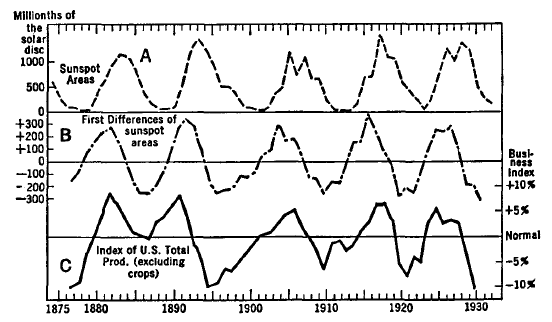
Fig. 54.
Sunspots and Manufacturing, 1875-1931
Sunspot areas and first differences (a measure of rate of change) of
sunspot areas compared to manufacturing production, U.S.A., all
values smoothed by 4-year moving averages. Note the dramatic
correspondence between B and C.
Of course, the supposed cause can hardly follow the result, so
Garcia-Mata and Shaffner reasoned that the rate of change in the
number of sunspots might be the cause. When the rate of change (B in
Figure 54) is compared to the index of total production (C in Figure
54), the correspondence is dramatic.
In 1881 the English astronomer N.R. Pogson traced an intimate
connection between sunspot frequency and grain prices in India.
In 1919 Professor Ellsworth Huntington advanced the idea that
variations in solar radiation had an effect on human beings and
thus, in turn, upon business conditions. His hypothesis ran contrary
to the popular belief that business was affected first, with the
business conditions then affecting human beings.
In 1936 Loring B. Andrews, a Harvard astronomer, called attention to
the apparent correlation over the preceding two hundred years
between sunspot activity and wars, international crises, and
economic distress. He conjectured that the cause of these and other
solar-terrestrial correlations might be either the intensity of
solar radiation or emanations of ultraviolet light. Since both of
these two solar phenomena are associated with sunspot activity,
Andrews felt that a variation in ultraviolet light was the more
reasonable of the two possible explanations for the economic and
sociological correlations.
In 1965 Charles J. Collins, an investment counselor, published "An
Inquiry into the Effect of Sunspot Activity on the Stock Market."
In
his article he noted that since 1871 the largest stock-market
declines, percentage-wise, coincided with or followed years in which
average sunspot numbers reached or exceeded a count of fifty.
The Time Lag
The jury is still out on the question of this important link between
the earth and sun. No verdict has been reached because of one
perplexing fact. Let me give you an example.
In an earlier chapter we discussed the brilliant Russian scientist
Tchijevsky and his discovery that, in the mass, our world seems to
increase in excitability in a consistent pattern of nine waves per
century. His work had involved detailed statistical research into
the histories of seventy-two countries.
Tchijevsky found not only that his index was characterized by
Il.II-year cycles but that the highs of these cycles tended to
correspond with highs in sunspot activity.
In 1960 I made a thorough investigation of Tchijevsky's work, using
sunspot data that were not available to Tchijevsky forty years
earlier. I discovered that when the years of maximum sun-spot
activity were compared with the values of Tchijevsky's Index of Mass
Human Excitability, the highs of the sunspot cycles followed the
highs of his Index by an average of about one year.
This time lag often occurs when earthly cycles are compared with
sunspots. In general, regardless of period, the sunspot cycles turn
after the corresponding earthly cycles they are supposed to create.
And you cannot have the cause follow the effect!
Can it be that something is causing both the cycles on the sun and
the cycles here on earth - but that the sun takes longer to respond?
Could our friends Garcia-Mata and Shaffner be right in that it is
the rate of change of sunspot numbers rather than the actual number
of spots that is the trigger to our earthly behaviors?
Could it be that since cycles of the same length here on earth tend
to have their highs later and later as they occur closer to the
equator, and since sunspots normally occur in the lower latitudes,
we must take these facts into consideration when trying to relate
the two?
Most events recorded here on earth with eleven-year cycles
occur between 40 degrees and 55 degrees north latitude, while
sun-spots lie, on the average, at about 14 degrees north and south
latitude on the sun, so there would normally be a time lag if the
two phenomena were the result of a common cause, and if cycles on
the sun behave like cycles on earth.
The evidence in favor of a relationship between solar activity and
behavior here on earth is provocative but not yet conclusive. Yet
new discoveries seem to be leading us closer and closer to a
solution to the great sunspot mystery.
One of these new clues,
uncovered by C. N. Anderson, of the Bell Telephone Laboratories,
followed this logical line of reasoning:
Sunspots increase and decrease in waves that range from seven
to seventeen years in length, but which have an average wavelength
of 11.11 years. Sunspots normally occur in pairs. Sunspots are
magnetized. In one wave of the sunspot cycle positive spots will
lead in the sun's northern hemisphere, negative spots will lead in
the sun's southern hemisphere.
In the next wave this situation is reversed:
Negative spots will
lead in the northern hemisphere; positive spots will lead in the
southern hemisphere.
Thus it takes two sunspot waves - or "cycles," as
they are called - for the behavior to come around again to the place
of beginning. The period of the double sunspot cycle is thus 22.22
years (see Figure 55).
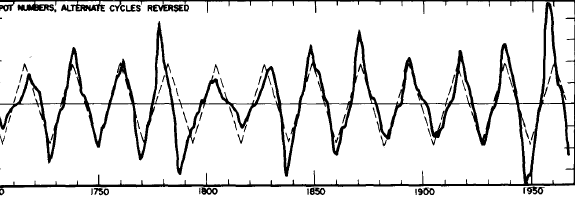
Fig. 55.
The Double Sunspot
Cycle, 1700-1968
Sunspot numbers with alternate 11.1 1-year cycles reversed.
The wavelengths of certain average cycles in sunspot numbers with
alternate cycles reversed correspond closely with the average times
when several of our planets line up with each other as seen from the
sun in what is called a "heliocentric planetary conjunction."
If
further investigation proves this association to be a real one, we
will have added importantly to our knowledge of solar-system
mechanics and to our ability to forecast ordinary sunspot numbers,
an ability of increasing importance as we enter the age of space
travel with its impending dangers from solar eruptions of all sorts.
The Solar Constant
Dr. C. G. Abbot, of the Smithsonian Institution, has spent the
greater part of his lifetime trying to convince meteorologists and
scientists in general that the "solar constant" is not constant but
fluctuates in cycles instead.
The "solar constant" is a measurement, in calories per square
centimeter per minute, of the amount of the sun's energy received.
As the name implies, it has little variation, but Dr. Abbot,
involved for many years with the measurement of this "constant,"
noticed what he termed "dent-like depressions," that is, small ups
and downs in the measurements.
These tiny ups and downs seemed to fluctuate in a cycle of 273
months - or almost twenty-three years. However, the small variation in
the solar constant - only 1 or 2 percent - was a serious stumbling block
for the meteorologists, who did not believe that the variations were
large enough to account for such changes in the weather as were
claimed by Dr. Abbot.
Dr. Abbot proceeded to project his cycles in the solar constant
backward and discovered that these cycles corresponded with past
weather conditions (Figure 56).
Then he began to prepare charts of
calculated precipitation or temperature based on his 273-month cycle
(Figure 57) and followed this with long-range calculations for
fifty-four weather stations. He published numerous papers covering
over fifty years of study, and the amount of evidence he marshaled
to support his case is impressive.
H.H. Clayton, chief forecaster of the meteorological service of
Argentina, discovered similar correspondences between variations in
solar radiation and barometric pressure (Figure 58) after learning
of Abbot's work on solar variation.
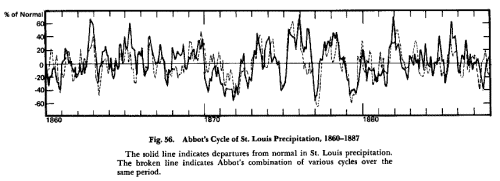
Fig. 56.
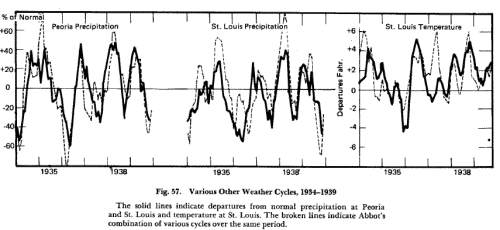
Fig. 57.
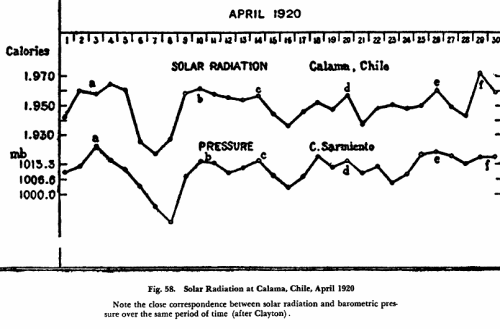
Fig. 58.
He applied his findings in
extensive long-range weather forecasting.
Except in Argentina no weather-forecasting service attached to any
government has ever taken solar variation into account, but I
suspect that Dr. Abbot's work will one day have its moment in court.
The Moon Cycles
Even before Neil Armstrong and Edward Aldrin stepped courageously
onto the surface of the moon, we "earthlings" had begun to refer to
it as the "seventh continent."
However, none of the six continents
floating placidly on the face of our earth can begin to approach the
effects that the moon and its cycles have on our life.
Although the sun is 26 million times larger in mass than the moon,
it is 389 times farther away and so the moon exerts a force on us
which is 2½ times greater than that of the sun. This tremendous
force is most evident in the behavior of our tides.
As the moon
circles our planet in a cycle of 24 hours, 50i/£ minutes, high tides
and low tides follow each other in most parts of the world every 12
hours, 25 minutes. This gravitational pull is strong enough to lift
millions of gallons of water as high as fifty feet in places such as
New Brunswick's Bay of Fundy. Since so much of you is water, is it
unreasonable to conjecture that the moon's cycles might somehow also
"lift" you?
There are three main moon cycles besides the daily one just
mentioned. The first is the monthly lunar cycle caused by the
revolution of the moon around the earth. The length of this monthly
cycle, relative to the sun (from full moon to full moon), is
29.53039 days.
The moon travels around the earth in an ellipse - a flattened
circle - with the earth near the center of this ellipse. This ellipse
wobbles like a poorly thrown football in a cycle that takes
thirty-one years and two or three days (depending on leap years) to
return to the point where it started. The axis of this orbit not
only wobbles but turns in a counterclockwise direction, making one
complete cycle relative to the stars every 3,232.6 days, or 8.85
years.
As you know from watching and reading about our astronauts, the
orbit of the moon is not exactly in the same plane as the orbit of
the earth. Looking at the two, from the side, for half the lunar
month the moon is a little above the line connecting earth and sun
and for the other half a little below it. The line where the planes
of the two orbits connect is called the line of nodes; this
intersection line, relative to the stars, is the same every 18.6
years.
Although man has made great advances in applying his knowledge of
the moon to the predicting of tides and their levels, he is only
beginning to explore other possible moon-earth relationships, for
now it is known that there are tides in the atmosphere that are
influenced by the force of the moon.
Changes in geomagnetism and
radio-field strength appear to follow the changing phase of the
moon, and movements of the earth's crust seem to relate to the
position of the moon. It has been estimated that the city of Moscow
rises and falls nearly twenty inches, twice a day, in response to
the moon's gravitational beckoning.
The effect of the moon on our physical environment is now under
intensive study, although complete and definite answers are still to
come. We have even begun to explore the realm of lunar folklore.
The
Department of Agriculture has investigated the question of whether
planting crops during certain phases of the moon will affect the
ensuing growth and yield of the crop.
They found that the phase of
the moon in which a crop is planted has no relation to its outcome,
although folklore may still have its basis in fact. It is said that
timber in the tropics must be felled at the correct phase of the
moon. If the trees are cut when the moon is waxing, the sap runs
heavy and draws beetles that eat the wood. Contracts to cut timber
in South America and the South Sea Islands sometimes specify that
the wood is to be cut only during the waning phase of the moon.
This phenomenon is not surprising if you will recall the work of H.
S. Burr with the electric voltage of trees. Burr drilled tiny holes
several feet apart (vertically) on a tree trunk and connected the
holes with wire. An electric current flows along such a wire, and
Burr has recorded this flow, minute by minute, for many years. The
current sometimes flows up and sometimes down.
Neither the current
nor the voltage is steady, but the same strength of current flows in
the same direction at the same time in trees that are miles apart!
The variation in voltage goes in cycles, and one of the cycles
observed appears to correlate with the phases of the moon. Of
course, the effect of the moon may be direct, or it may be
secondary.
Remember Professor Frank Brown and his pieces of potato hermetically
sealed in rigid containers under constant conditions of pressure and
temperature? They gave evidence, among other things, of a lunar
monthly rhythm of oxygen consumption. The rate was lowest at the
time of the new moon and went up to a high during the third quarter
of the moon.
Thus there is solid evidence that does indicate that plants respond
to some extent to the changing phases of the moon. Lunar cycles in
plants exist, although research on this phase of the earth-moon
system is also in its infancy. It is logical that work on the effect
of the moon would start first with the tides, on which our facts are
remarkably complete, then move to other physical aspects (air,
geomagnetism, etc.), then move to plants and animals, and lastly,
concentrate on man - for man hesitates to admit that he is influenced
by any environmental forces!
The lunar cycles of life in the sea and on the seashore are obvious.
One of the classic examples is the palolo worm of the South Seas.
This small native delicacy has an elongated posterior filled with
reproductive cells. These posteriors break away from the worm's
body, which is lodged in burrows in the coral rock, and swarm to the
surface of the sea - but only in early morning for two days during the
last quarter of the moon during October and November. How does the palolo know when the moon is in its final quarter - and in just two
out of thirteen lunar months?
During April and May, grunions, small edible fish native to the
coast of California, throw themselves on the beaches until they
nearly cover the white sand. But they do this only after the moon
and the sun have cooperated to produce the fortnight's highest high
tide. On the beach the female grunions scoop shallow depressions in
the wet sand and deposit their eggs. The eggs remain, since later
and lesser tides do not disturb them. When the next highest high
tide arrives, some fifteen days later, the eggs will hatch and the
fry will enter the sea.
What force guides the grunion to deposit its eggs in the sand after
the highest tide and not before? And how does it know exactly which
tide will be the highest? For if another and stronger tide
immediately followed the deposit of eggs, they would be washed from
the sand and have no chance to develop.
The effect of moon on man is buried deep in the consciousness of the
race. The word lunacy, for example, came into use because of a
general belief that the moon triggered certain forms of insanity
that occurred in phase with the moon.
Sleepwalking is sometimes attributed to the influence of the full
moon, and certainly the supposed romantic influence of the moon has
been the source of much income to song writers. In addition to these
and other traditional beliefs there is much scientific evidence of
the moon's influence on human activity. In 1950 I published a
summary of the number of births occurring in the waxing and waning
period of the moon.
The record covered the period from 1939 to 1944
and was supplied by Curtis Jackson, then Controller of the Methodist
Hospital of Southern California. Of the babies born at the hospital
during the time covered, 17 percent more were born during the waxing
period of the moon than were born during the waning period. In some
of the years births in the waxing period of the moon exceed by as
much as 25 percent those in the waning period.
What could be the reason for this behavior? Does it imply a
cause-and-effect relationship between the moon and amorousness or
fertility? Or is there a rhythm in amorousness or fertility that
just happens to correspond to the waxing and waning of the moon? The
answers to these questions lie in the field of medicine and outside
the study of cycles. We can do no more than pose the question.
Physical and experimental science must provide the answers.
Dr. William F. Petersen was one of the truly great men I have known
in my lifetime. Although primarily a medical doctor, he felt that in
addition to acquiring greater knowledge about bacteriology and
immunology, it was imperative that we do everything possible to
relate man to his environment. He believed that however minor they
might be, cosmic influences should be taken into account.
While studying the moon's effect on man, Petersen compared various
-kinds of vital statistics with various phases of the moon to see if
there were any relationships. These statistics included conceptions
compared to deaths, the incidence of scarlet fever, the incidence of
epileptic attacks, deaths from tuberculosis, and others.
There appeared to be a definite lunar phase to the chart of deaths
from tuberculosis, with an increase in deaths after the full moon.
Nevertheless, this is only one factor. Certainly, in any individual
case, local weather conditions, the condition of the patient, and
other related factors are much more important than the phase of the
moon. Nevertheless, when put on a lunar axis and smoothed by a
three-day moving average, the record of deaths from tuberculosis
does show a high seven days after the full moon and a low eleven
days before the full moon.
Researchers are constantly accumulating evidence that tends to show
that the moon exerts an influence on earthly affairs, both in the
physical environment and in plants and animals.
As with nearly every
other subject in this book, the material I have presented is the
smallest of summaries of a subject that requires a complete book of
its own.
The Variable Stars
Our universe is replete with cycle activity.
The planets are
spinning in cycles; Jupiter completes one rotation every nine hours
and fifty minutes while Pluto takes six days, nine hours, and
twenty-one minutes to do the same thing. All planets are also
revolving around the sun in cycles; Mercury requires only 2.89
months for a round trip while it takes Pluto 2,981 months to
complete its tremendous ellipse around our sun.
A third type of
planetary cycle involves the length of time it takes for any two
planets to line up in a straight line with the sun.
Our earth is on
a straight line with Mercury and the sun every 116 days, while we
only manage to get in line with Mars and the sun every 780 days.
These conjunctions, of course, offer a great area for finding
possible effects on earthly things, but science has pretty much
ignored this area of investigation and left it to the astrologers.
However, there are enough hints of a possible relationship between
periods of conjunction between our earth, the sun, and other planets
so that I'm not sure this idea should be left to them.
Several thousand stars also have cycles. They are called variable
stars, and their brightness fluctuates in periods that vary from a
few hours to several years. Furthermore, the intensity of the light
curves of some of these stars fluctuates in the typical zigzag
pattern that characterizes many cycles in both solar and earthly
phenomena.
For example, refer to Figure 59, reprinted from Astronomy by W. T.
Skilling and R. S. Richardson, published and copyrighted by Henry
Holt and Company. These curves show that the stars to which they
refer get brighter and fainter in the sort of pattern that would
result if some master hand pulled a reversing switch at more or less
regular intervals.
Variable stars fluctuate in all sorts of wavelengths. The most usual
lengths are 1/2 day, seven days, and 250 days.
What causes the change in brightness of the variable stars? No one
really knows.
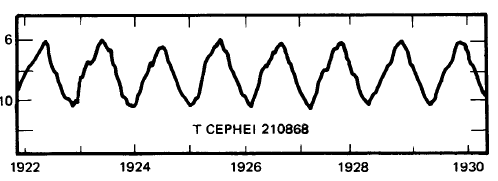
Fig. 59.
A Cycle in a Variable Star, 1922-1930
The light curve of the star T Cephei. The wavelength is 387 days.
The Comet Cycles
In 1704 the English astronomer Edmund Halley published a paper in
which he predicted that a comet that had appeared in
1682 would reappear in 1759.
It did, and its reappearance
established the fact that comets, although they travel in extremely
eccentric orbits, have cycles of revolution around the sun. Halley's
Comet is scheduled to make its next appearance in 1985.
Hundreds of other lesser-known comets orbit the sun in cyclic trips
that are as short as 2.3 years. No one knows how comets originated
but astronomers can give you the orbiting cycle for every one so far
discovered.
Quasars, Pulsars, and Cycles
Since 1962 two new phenomena have generated tremendous excitement
among the world's astronomers.
Quasars (for quasi-stellar radio sources) appear to be closely
packed groups of millions of stars, smaller than galaxies. They were
first detected by radio telescopes.
Apparently they are so distant
that, traveling at the speed of light (186,000 miles per second), it
has taken 6,000 million light-years for the energy and light from
some of them to reach this planet. Radio waves charted at the Jodrell Bank radio telescope in England on June 7, 1966 (Figure 60),
began their journey through space over 1,000 million years before
the earth came into existence.
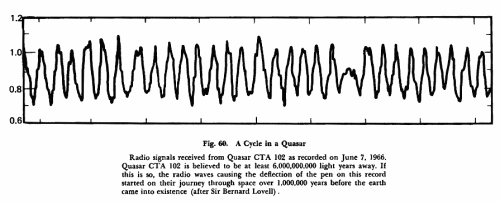
Fig. 60.
I need not point out to you the fairly regular wave or cycle.
Quasars are also known to fluctuate in brightness, presenting us
with another puzzle. This mysterious aspect is illustrated by Quasar
3c273.
It is approximately seven light-years in diameter, which
means that it would take seven years for electromagnetic waves to
cross the entire quasar. If so, how could the different stars in the
quasar all fluctuate in brightness together? How could the different
stars know when to be bright and when to be dim so that separated by
billions and billions of miles they still act like a string of bulbs
on our Christmas tree, synchronized to blink in unison?
Pulsars are believed to be small balls of debris, only a few miles
in diameter, left in space after the explosion of some stars.
On
these mini-planets, which are composed of densely packed atomic
particles called neutrons, are small areas with gigantic magnetic
fields firing extremely strong radio signals - and often light waves -
into space. As they spin, they spray these waves across the face of
our earth in cycles.
Some pulsars sweep the earth every thirtieth of
a second while others have cycles as long as 3.7 seconds.
Cycles in Radio Weather
Before his recent retirement John H. Nelson held, for over two
decades, the position of propagation analyst for RCA Communications.
His responsibility was to forecast daily radio weather so that
shortwave radio transmissions would not be interrupted by "poor
radio weather."
Radio waves cannot travel in a circle around the earth. They must be
bounced off the ionosphere, a layer of rarefied gas enveloping the
earth 200 miles up. This ionosphere "ceiling" is created by
radiation - particularly ultraviolet - from the sun. Whatever it is that
affects radio communication is presumably something that affects the
ionosphere.
We do not yet know what this "something" is, but Nelson discovered
that it is associated with the angular relationship between the
planets as viewed from the sun. Imagine yourself up in space looking
down upon the solar system with the sun in the middle and the
planets revolving at various distances around it. Draw imaginary
lines from the sun to each of the planets.
Each of these lines, of
course, will be distant from each of the other lines by a certain
number of degrees. If at any instant any three or more planets are
so situated that the angular relationship between the lines
connecting them and the sun is 15 degrees or some multiple of 15
degrees (Figure 61), the quality of radio propagation will be
affected, provided one of the angles is 60 degrees, 90 degrees, 120
degrees, or 180 degrees.
For important disturbances there must also be at least two
fast-moving planets and one or more slow-moving planets involved in
the configuration.
The fast-moving planets are Mercury, Venus,
Earth, and Mars; the slow-moving planets are Jupiter, Saturn,
Uranus, Neptune, and Pluto. The fastest moving planet is looked upon
as the "trigger" planet.
It is as simple as that - but it is still all
very mysterious, and John Nelson is the first to admit that he
does not know why certain angular relationships of our planets are
associated with disturbed weather.
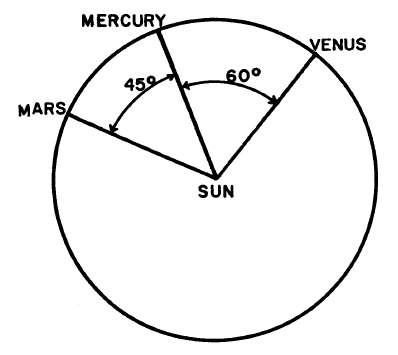
Fig. 61.
Planetary Relationships
Diagram to show Mercury 60° (four times 15°) from Venus,
Mars 45°
(three times 15°) from Mercury, and 105° from Venus.
This
configuration will affect the quality of radio weather.
But indubitably they are.
John Nelson's work has illustrated another successful application of
forecasting based upon a knowledge of cycles. With this knowledge,
according to the last report I had received, he had made 1,460
forecasts during 1967.
His accuracy rating was 93.2 percent! His
discovery that there is a correspondence in timing and time span
between the cycles of shortwave radio disturbances and planetary
cycles also shows how a knowledge of cycles can suggest the
possibility of a cause that might otherwise be unsuspected. We must
learn if there are correspondences between these planetary cycles of
his and other phenomena here on earth. Are there corresponding
cycles in weather, for example, or corresponding cycles in plants,
or animals, or man?
Now you are perhaps aware of the scope of our mystery. Its clues are
everywhere, from a tiny microscopic one-celled creature fluctuating
in abundance in the waters of our world to quasars, pulsating in
cyclic brilliance and energy over 6,000 million light-years away.
Is all this rhythmic behavior here on earth and "out there" merely
coincidence?
Let us gather together some of these "clues" and see
what we have.
Back to Contents
|











